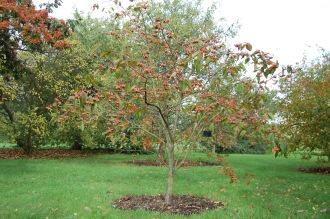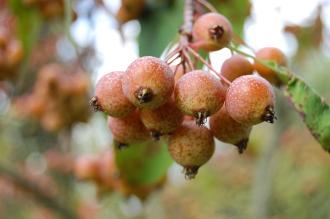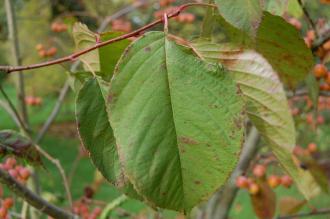
Malus prattii (21/10/2013, Kew Gardens, London)
Position: Full sun to partial shade
Flowering period: Late spring
Soil: Moist, well drained
Eventual Height: 10m
Eventual Spread: 10m
Hardiness: 6a, 6b, 7a, 7b, 8a, 8b, 9a, 9b
Family: Rosaceae
Malus prattii is a deciduous tree with a rounded habit. Its mid green leaves are ovate to elliptic with serrate margins, up to 15cm long and 7.5cm broad. Its fragrant white/ pink flowers are up to 2cm across and appear in groups of up to 12. Its red/ yellow fruit are pomes, up to 15mm across, appear in autumn and persist on the tree during the winter months.

Malus prattii Fruit (21/10/2013, Kew Gardens, London)
Malus prattii, commonly known as Pratt’s Crabapple, is native to south east China. In its native habitat it grows in open or mixed forests.
The etymological root of the binomial name Malus is the ancient Latin name for the apple tree. Prattii is named after Antwerp Edgar Pratt (1850-1920), a British Zoologist.
The landscape architect may find Malus Malus prattii useful as a small tree with attractive spring flowers, autumn leaf color and winter fruit.
Ecologically, Malus prattii flowers are attractive to pollinating insects. Its fruit are attractive to birds and some mammals.

Malus prattii Leaf (21/10/2013, Kew Gardens, London)
Malus prattii prefers moist, fertile, well-drained soils. It tolerates most pH of soil.
Malus prattii requires little maintenance.

